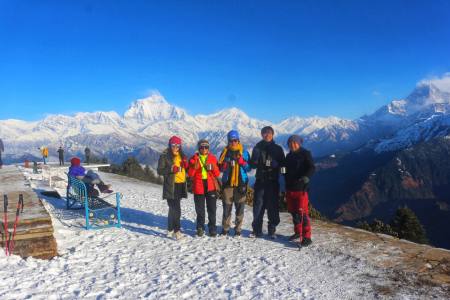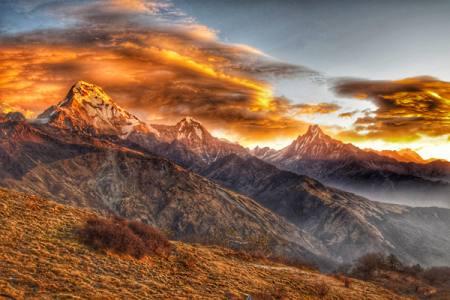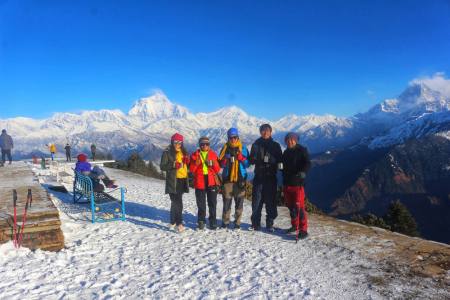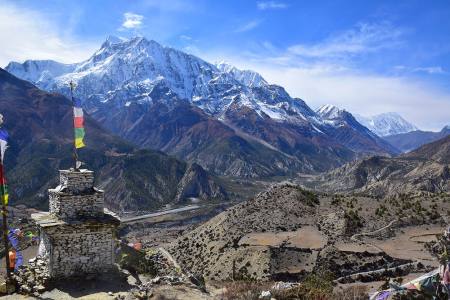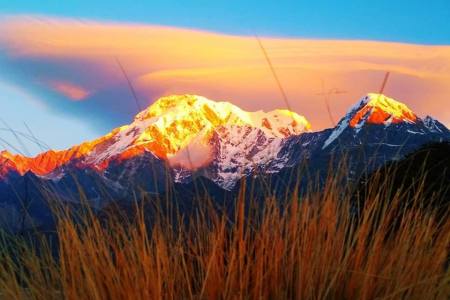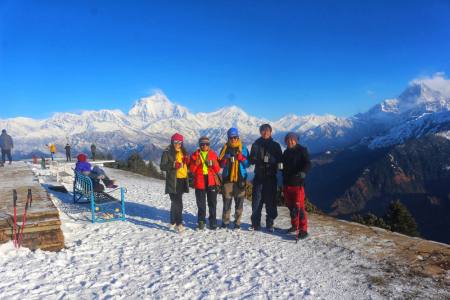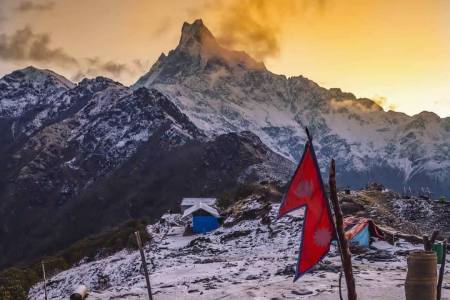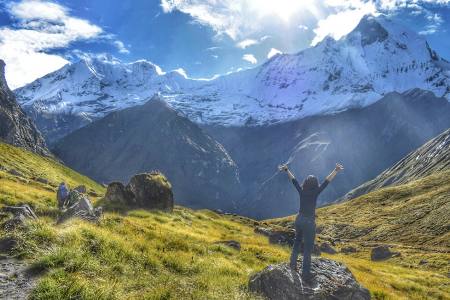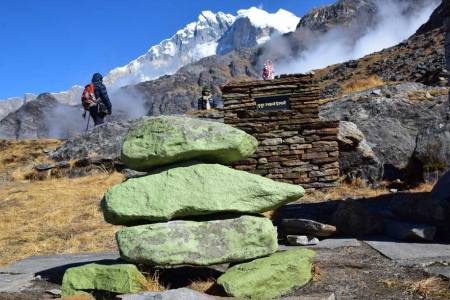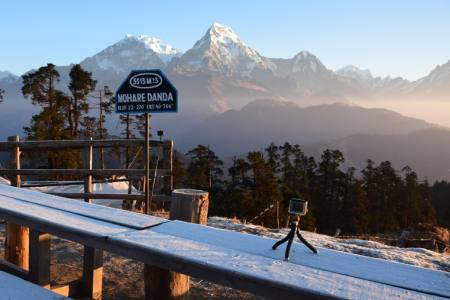- +977 9841062222 WhatsApp, Viber
- [email protected] Ask travel Experts
Sikles Kapuche Lake Trek
Sikless Kapuche Lake trek is one of the best emerging trekking routes in Nepal. Along with a unique location and pristine natural presence, the path is remote and less crowded than other trails. So, if you are looking for a trekking route that offers grand scenery, an isolated lifestyle, and a rarely hiked trail, then Khapuche has much to offer. The Lowest Glacier Lake lies to the north-east of Kaski. It is a short trek that begins at Pokhara and goes through several villages and hills. Although the trekking route was recently discovered and opened for visitors, it has been slowly gaining popularity due to its natural beauty and unique trekking experience.
This is a newly offered off-the-beaten-path trek to Glacier Lake Kapuche at an altitude of 2450m. Kapuche in the local Gurung language means ‘Ka” which means Ice or snow, “Fu” means breaking down and sliding down after the break, and “Che” means landing on the plain land, which is formed by the continuous avalanche from the Annapurna II and Lamjung Himal. Kapuche is claimed to be the only glacial lake located at the world’s lowest elevation. Mt Annapurna II (7939m), Mt Lamjung Himal (6893m), and the neighboring snow-capped high mountains are the perennial source of this lake.
The trail follows pristine nature, pure wilderness, teeming with flora and fauna of the tropical and coniferous dense forest. You will walk through a typical village settlement inhabited by the indigenous community mainly Gurung & Tamang and experience their traditional rural culture very closely. Tara Hilltop en route situated at a height of (2814m) provides the best close-up views of the Himalayas (Snow Capped Mountain). You can truly enjoy the breathtaking panoramic views of the entire Mt Annapurna Himalaya Range from a very close distance at the backdrop of magnificent landscape throughout the trip.
The Kapuche Glacier Lake is located at an altitude of (2546 m) from sea level. It lies inside the Gurung Village Sikles of Kaski District in the Annapurna region.
Sikles trek in Kaski District has been the most loved trekking area among trekkers, as it is one of the picturesque treks that unfold the natural beauty in Nepal. The charming villages, intriguing patterns of terraced fields, rhododendron forests, and high alpine meadows nestled below the towering mountains of Annapurna II (7939m) and IV (7525m) are some of the key features of this trek. This trekking is also known as royal trek as Prince Charles had a trek through the area in 1980 to visit the villages of Gurkha recruits, as part of an effort to develop this into a model eco-trekking route. But it has yet shadowed at the corner of the Annapurna Conservation Area under the Lamjung Himal and Annapurna II and IV.
The Sikles Kapuche Lake Trek is a beautiful camping trek in the Annapurna region and socio-cultural travel into a traditional Gurung Village of Annapurna which has been an inhabitant in this region since old times. This Sikles Trek is classified as a short trekking adventure where the travelers start trekking from lowland villages, rhododendron forests, and farming lands elevating to the height of 3000 meters in the Sikles Village of Gurung Civilization. The travelers starting from Hemja village traverse through rough terrains of the Annapurna region towards Fishtail Mountain and reach the traditional valleys of Sikles, Tang Ting, and Bhunjung in the end. The trekking trail is the ancient traveler’s trail of Madi Khola Valley generally used by the local shepherds during high alpine summer grazing. The Sikles Trek is a camping adventure where the travelers land in the southern Annapurna region of real rural Nepal where travelers camp at nature’s lap, eat the local foods, and enjoy the wonderful nature around them. The Sikles is one of the largest Gurung Settlement of the Annapurna Region dominated by closeby views of Annapurna, Lamjung, Fishtail, Dhaulagiri Himalayas, and other associated Himalayas. This is an easy trekking adventure not crossing 2500 meters of elevation so there is no fear of altitude sickness during the trekking adventure.
Trip Highlights of Sikles Kapuche Lake Trek
- An off-the-beaten-path hiking trail offering spectacular views of Mt. Annapurna, Machhapuchhre, and Lamjung Himal.
- Discover Kapuche Glacier Lake, the lowest-lying glacier lake in the Annapurna region of Nepal, situated at an elevation of 2450 meters above sea level.
- Enjoy an easy to moderately challenging hike through quaint settlements, lush greenery, terraced farms, and oak and rhododendron forests.
- Learn about the Gurung people, their religion, culture, traditions, and way of life while participating in a low-altitude hike to Kapuche Lake.
- Experience the warmth of the Gurung people in Sikles Village, one of the largest Gurung settlements, and explore their rich cultural heritage.
- Visit the Eco-Museum and Chili Kohinbo Temple in Sikles Village to learn more about Buddhism and the Bon religion.
- Witness a variety of wildflowers on this low-crowd trek, which is accessible to people of all ages in good health.
Outline Itinerary:
- Day 01: Arrival in Kathmandu and transfer hotel (1360m)
- Day 02: Drive or Fly from Kathmandu (1400m) to Pokhara (822m)
- Day 03: Drive from Pokhara (822m) to Sikles (1980m)
- Day 04: Trek from Sikles (1980m) to Hugu Goth (2016m)
- Day 05: Trek from Hugu Village (2016m) to Kapuche Lake (2450m) and back to Sikles (1980m)
- Day 06: Drive from Sikles (1980m) to Pokhara (822m)
- Day 07: Drive or Fly from Pokhara (822m) to Kathmandu (1360m)
- Day 08: Final Departure
- Day 01 :Arrival in Kathmandu and transfer hotel (1360m)
- Day 02 :Drive or Fly from Kathmandu (1400m) to Pokhara (822m)
- Day 03 :Drive from Pokhara (822m) to Sikles (1980m)
- Day 04 :Trek from Sikles (1980m) to Hugu Goth (2016m)
- Day 05 :Trek from Hugu Village (2016m) to Kapuche Lake (2450m) and back to Sikles (1980m)
- Day 06 :Drive from Sikles (1980m) to Pokhara (822m)
- Day 07 :Drive or Fly from Pokhara (822m) to Kathmandu (1360m)
- Day 08 :Final Departure
Cost Includes
Transfers and Transportation:
- All airport pickups and drops via private vehicle
- Hotel transfers via private vehicle
- Tourist bus tickets from Kathmandu to Pokhara and vice versa
- 4WD jeep to Sikles (trek start point) from Pokhara
Accommodation:
- 2 nights in a hotel in Kathmandu (one night before the trek and one night after the trek)
- 2 nights in a hotel in Pokhara (one night before the trek and one night after the trek)
Meals and Accommodation during the Trek:
- All meals (breakfast, lunch, and dinner)
- Accommodation in tea houses or homestays
Permits:
- All necessary permits for trekking
Guide Services:
- An experienced and qualified English-speaking guide
- Guide expenses for food, lodging, transportation, salary, insurance, and equipment
Cost Excludes
Transfers and Transportation:
- International airfare
- Flight between Kathmandu and Pokhara (USD 100 each way)
Meals:
- Lunch and dinner in Pokhara and Kathmandu
Porter Services:
- Optional porter service (carries up to 20 kg) at USD 25 per day
Beverages:
- All drinks, including hot drinks, soft drinks, alcohol, and mineral water
Personal Expenses:
- Bar bills, battery recharges, extra porters, bottled or boiled water, showers, etc.
Additional Costs:
- Costs or delays due to factors beyond management’s control, such as landscape changes, adverse weather conditions, itinerary modifications for safety, illness, changes in government policy, political instability, strikes, etc.
Other Expenses:
- Any expenses not mentioned in the inclusion section
- Personal trekking equipment and rescue operations in case of emergency
Tips:
- Tips for staff (generally expected after completing the Kapuche Lake Trek)
Best Season for the trek to Sikles Kapuche Lake
Autumn Months: September to November
The month of September is a bit unique. During September, one can see the last traces of monsoon with short bursts of rain for the first two weeks. As mid-September kicks in the monsoon also ends and one can enjoy the autumn season. The temperature during this month ranges from 18-22 degrees Celsius in the day as it’s quite warm. October and November are the most popular trek months to visit any region in Nepal. This month is filled with blue skies and freshly vitalized natural vegetation, a clear sky, and less haze. During this month the average temperature during the day is 15 degrees Celsius and during the night it’s slightly colder as the temperature drops to 7-8 degrees Celsius.
Spring Months: March to May
The months ranging from March to May are the spring months in Nepal and are another most popular time of the year for undertaking trekking in any region. The month is full of beautiful wildflowers and splendid views of the snow-capped mountains. The average temperature is around 18-22 Degree Celsius during these months in the daytime and the temperature can drop to chilling levels.
Monsoon/Summer: June to August
These months are known for the tenacious monsoon season in Nepal. On a clear day, it’s quite warm in the daytime and makes trekking easier, and clear during the nighttime, it can get quite chilly.
Winter Months: December to February
These months signify the winter month in Nepal and are the coldest months. During the daytime, normally the temperature ranges from 7-12 Degrees Celsius in the lower regions. But for the mid regions of 2000-4000m, the temperatures are slightly lower. During the daytime, the temperature is normally 2-8 Degree Celsius. The nights are much colder than the daytime so warm clothing is a must during these months. The early month of February is still a bit chilly and has a hint of winter in it. But by the middle of the month, the spring makes its way and the arrival of clear days. One can see the beautiful hillsides immersed with the blossom of various rare flowers. The temperature during the daytime is 7-12 Degree Celsius and at night time the temperature can drop below zero degrees.
Tips for trek
Without at least some pre-trip training or a good basic level of fitness, trekking is hard work. Let’s be real – it’s hard work anyway. The toll for a great trek is paid in sweat. Sore calves and aching quads are badges of honor, with blisters and lost toenails marks of pride. But in return, you get some of the most untouched, pristine, and jaw-dropping scenery on the planet. And you know what? The more you train for your epic hike, the easier it’ll be. Some of the basic things to be carried along while trekking are:
- Water Bottle: A savior in many ways
- Munching Items: Trial Mix, Dry Fruits, Chocolate or Energy Bars
- Backpack: Travel Light & Organized
- Trekking Shoes or Hiking Boots: Walk the talk on your Hike or Trek
- Swiss Knife: A multi-purpose toolset
- Torchlight or Flashlight: Find the way in the dark
- Hand Sanitizer: Kill the unwanted germs
- Trek Pants or Trousers: Feel the comfort
- Cap or Hat: Get in the shade
- Sunscreen, Sun-Blocks, and Lip-Cares: Prevent the sunburns, moisturize your skin
- Trek Route or Map: Don’t get lost
- Medical First-aid Kit: Helps patch up basic health issues
- Cameras and other Gadgets: Capture the moment
Accommodation, Meals, and Water during the Kapuche Lake Trek
The accommodation during the trek toSikles Kapuche Lake will mostly be in the tea house and is also highly depends upon the routes as well. You can also opt for a camping trek as some of the areas of this region may not have tea houses as many as the frequent trekking routes have.
In the Sikles Kapuche Lake trek, we will enjoy authentic Nepalese food with a few other cuisines like Tibetan, and Indian. Meals will be served as per the menu of the teahouse or lodge. Besides that you can find bars, bread, cookies, butter tea, and extras on the trail but, remember as the elevation gets higher, the cost also gets high. Drinking water can be easily found everywhere. You can get hot water from the teahouse and fill in your bottle every time it gets empty. Avoid plastic mineral water bottles as they will help in preserving the region. Moreover, you can also carry water purifier tablets with you to purify the water.
How to prevent Altitude Sickness during the trek?
A common but unavoidable problem during the trek is altitude sickness. Altitude sickness is common in higher elevations and is a very crucial issue in the trek. The different body reacts differently to altitude sickness. Some may find it very difficult whereas others can adjust well. Altitude Sickness is caused by ascending too quickly. It is wise to climb slower to prevent it. As, it is very common on most of the treks and can happen to anybody, irrespective of how old or fit you are or if you have previous trekking experience. So, some of the ways to prevent Altitude Sickness are:
- Hydration – Drink plenty of water, it’s very important to stay hydrated.
- Trekking Pace – Walk at your own pace, take your time, and don’t go too fast.
- Eat Carbohydrate foods – It’s not often we’re told to eat extra carbohydrates but when you’re at higher altitudes, you need more calories.
- Avoid Alcohol – Alcohol, cigarettes, and medicines like sleeping pills can make altitude sickness symptoms worse. So, avoid it as much as possible.
This trek is truly one of the most fascinating and rewarding experiences in Nepal. The trekkers will get an opportunity to experience the close view of primitive society that has remained unaffected and unchanged by modernization for centuries. To experience the multicultural and the panorama of spectacular high mountains, different lifestyles, and an amazing view of natural beauty, is worth it and is a must-recommended trek of the Himalayas in Nepal
-
Trip Duration 8 Days
-
DestinationNepal
-
Trip Difficulty Easy to Moderate
-
Trip StyleTrekking
-
AccommodationHotels, Lodges and Tea Houses
Trip Essential Info
Dates & Prices
Are you looking for a joining group to Sikles Kapuche Lake Trek? Nepal Trail Finder Treks offer you the fixed departure dates to Sikles Kapuche Lake Trek for 2025/2026
As your holiday clock is ticking and you are ready to unleash yourself into the trekking trail of Nepal, this is important to pick your favorite trekking route and book the trek before it is too late. Nepal Trail Finder Treks is the ultimate choice for all trekkers for all kinds of trips in Nepal, Tibet, and Bhutan. Nepal Trail Finder Treks have set multiple departure dates that may suit your vacations in the Himalayas. You can request your own departure dates if the dates we have selected do not match your schedule.
Why Nepal Trail Finder Treks for fixed departure group joining?
- Zero compromises in safety, comfort, and quality.
- Best hospitality with the best price.
- We manage to run your trip according to your budget.
- Fully customizable and tailor-made trips offered.
- Best service by experienced and hardworking field staff.
- 100 percent trip success rate.
- No incomplete treks are done so far.
- Compatible for any date to start and finish the trek.
An itinerary can be customized according to your choice.
Please, note that the itinerary is posted to give you an idea of where we are staying and which route we are taking. Feel free to customize the trip as per your schedule; we finish it shorter/longer than supposed.
| Trip Dates | Availability | Space Left | Price From | |
|---|---|---|---|---|
| December 02, 2026 - December 09, 2026 | Guaranteed | 9 | US$ 575 | Book Now |
| December 09, 2026 - December 16, 2026 | Guaranteed | 9 | US$ 575 | Book Now |
| December 16, 2026 - December 23, 2026 | Guaranteed | 9 | US$ 575 | Book Now |
| December 22, 2026 - December 29, 2026 | Guaranteed | 9 | US$ 575 | Book Now |
| December 31, 2026 - January 07, 2027 | Guaranteed | 9 | US$ 575 | Book Now |

